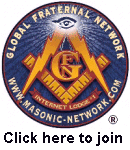
The GFN Treasure Chest Archives
www.masonic-network.com
"Where Master Masons Communicate"

 |
The GFN Treasure Chest Archiveswww.masonic-network.com |
 |
The transformation [from a trade organization to modern Freemasonry] began in Scotland, and its key figure was a man hwo is hardly remembered today. His name was William Schaw (c. 1550 - 1602), and he was master of works to King James VI of Scotland. This position gave him authority over the nation's lodges of masons, and he soon regularized their organizatin and incorporated new elements into their practice. In 1598 and 1599, he issued two sets of statutes that were to radically alter the face of Masonry. One of the most curious provisions enjoined the lodge warden to test every applicant for membership in "the art of memorie and science thairof." As I've noted in regard to Giordano Bruno, the Renaissance art of memory involved intense powers of visualization, including the construction of a "memory palace." We do not know whether Schaw introduced the art of memory to the Masonic lodges of Scotland or whether it had been practiced before his time. Nor is it certain that his "art of memorie" was akin to Bruno's; it may have been something simpler designed to facilitate rote learning of rituals. At any rate, this provision suggests that Masonic training at the end of the sixteenth century included some esoteric knowledge."
David Stevenson, The First Freemasons:
"The man who more than anyone else deserves the title of creator of modern freemasonry was William Schaw. . . . As general warden and master of works Schaw issued two codes of statutes, in 1598 and 1599. In these he laid down regulations for the organisation and practice of the mason craft through a system of 'lodges'. . . . What was William Schaw trying to do -- and why? At first sight it might seem that his statutes are solely concerned with the organisation and regulation of the working lives of stonemasons. Certainly this was central to his work, but there are enough hints in the statutes themselves, and in evidence which soon follows and relates to developments arising from the statutes, to make a very strong case for arguing that he was doing much more, reviving and developing Medieval masonic mythology and rituals in a Renaissance atmosphere. But naturally this secret and esoteric side of his work was not committed to writing in his statutes. . . . One branch of the Hermetic quest centred attention on the art of memory. . . . In his second code of statutes William Schaw had ordered that all masons be trained in the art of memory and be regularly tested in it. . . . In its most common forms, the art of memory had an architectural framework. To memorise a speech the practitioner created in his mind a complex building with many rooms, furnished with images or symbols in set locations. He then moved mentally through this building on a fixed route, assigning each idea in his speech in turn to one of the images. Then, in giving his speech, he again walked in his mind through this building, and as he came to them the images would remind him in the correct order of the ideas he wished to express. . . . The great quest was to be pursued through a mystical building,, and buildings were the creation of masons/architects. When, late in the seventeenth century, details of the rituals of the early Scottish freemasons become known, the descriptions of the lodge within which rituals were performed, and the symbolic significances assigned to different parts of the lodge and objects in it, this can be interpreted in terms of the lodge being envisaged as a temple of memory, still largely mental but given some concrete reality through the performance of rituals, in a room with, perhaps, marks on the floor indicating its supposed features."
David Stevenson, The Origins of Freemasonry:
"Thus William Schaw, master of works, worked at a court where the art of memory was known and even the king took an interest in it. . . . It is conceivable that the art of memory, in some form, was used by Scottish masons before 1599, for though it can usually only be studied today through the works of the scholars who wrote about it, it was used by men at all levels of society. . . . Moreover, it was of course particularly suitable for helping in the transmission of material regarded as too secret to be committed to writing. . . .The features of the classical art of memory which made it seem particularly relevant to the mason craft are obvious. The art was based on moving through an elaborate building, and it was an art which was believed to give great powers to the adept by vastly increasing the capacity of human memory. . . . What did Schaw and the masons use the art of memory for? The general striving for mystical enlightenment is doubtless present, but, as has already been suggested, it was probably also employed for mundane purposes, such as memorising the Old Charges. The two are not entirely separate, however: the search for knowledge of the divine was based on Hermetic theories of ancient Egyptian knowledge, and Hermes and Egypt have an important place in th Old Charges. Finally, and most excitingly of all for understanding the emergence of freemasonry, it will be argued in the next chapter that the seventeenth-century masonic lodge may have been in one sense a memory temple, an imaginary building with places and images fixed in it as aids to memorising the secrets of the Mason Word and the rituals of initiation."
Mackey, Encyclopaeia:
"SCHAW MANUSCRIPT
This is a code of laws for the government of the Operative Masons of
Scotland, drawn up by William Schaw, the Master of the Work to James VI. It bears
the following title: "The Statutis and Ordinanceis to be obseruit be all the
Maister-Maissounis within this realme sett down be William Schaw, Maister of
Wark to his Maieste and general Wardene of the said Craft, with the consent of
the Maisteris efter specifeit."
As will be perceived by this title, it is in the Scottish dialect. It is written on paper, and dated XXVIII December, 1598, Although containing substantially the general regulations which are to be found in the English manuscripts, it differs materially from them in many particulars. Masters, Fellow Crafts, and Apprentices are spoken of, but simply as gradations of rank, not as Degrees, and the word Lodge or Lodge is constantly used to define the place of meeting.
The government of the Lodge was vested in the Warden, Deacons, and Masters, and these the Fellow-Crafts and Apprentices were to obey. The highest officer of the Craft is called the General Warden. The Manuscript is in possession of the Lodge of Edinburgh, but has several times been published—first in the Laws and Constitutions of the Grand Lodge of Scotland, in 1848 then in the American edition of that work, published by Doctor Robert Morris, in the ninth volume of the Universal Masonic Library; afterward by W. A. Laurie, in 1859, in his History of Freemasonry and the Grand Lodge of Scotland; D. Murray Lyon in History of the Lodge of Edinburgh gives a transcript and the last part in facsimile, and, by W. J. Hughan."